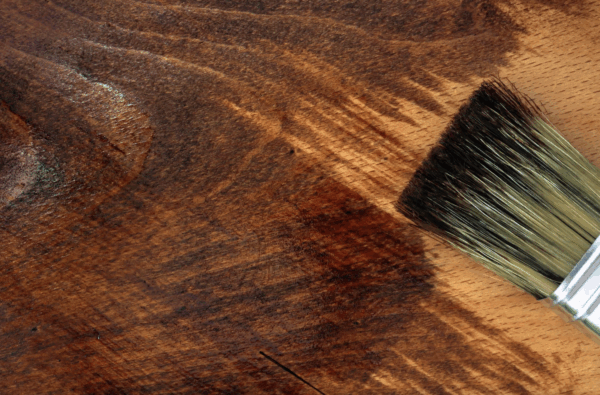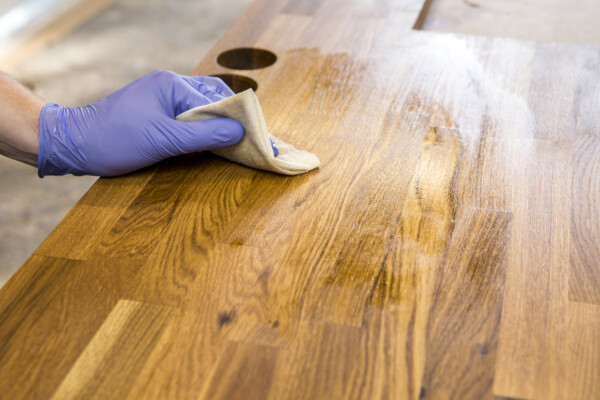How to Stain Wood (The Right Way)
Staining wood highlights its natural grain and color, adding both warmth and protection. Simply put, it makes the piece look finished and refined. If you’re looking to add stain to your own wood piece, there are some important notes to make before getting started.
First, you’ll want to gather the essentials: sandpaper (120–220 grit), wood stain (oil- or water-based), clean cloths, a foam brush or paintbrush, optional wood conditioner, and a clear topcoat (like polyurethane).
H.A. Stiles offers high-quality architectural wood parts, including columns, balusters, and newel posts, that can be sold unfinished and ready for stain. This means you’re starting with a clean, raw surface for this process.
If you’re staining a permanent part of your home, this isn’t a process to view as a cosmetic step. When done properly, staining helps preserve the wood, protect the investments you’ve made, and maintain your home’s architectural integrity for years to come.

Applying Wood Stain with a Brush on Grain-Ready Surface
Brushing on wood stain brings out deep grain tones and color variation.
Preparing the Wood Surface
Start with sanding. We recommend using medium-grit sandpaper (120 grit or so) to knock down rough spots. Then, switch to finer grits like 180 or 220 to smooth things out. Always sand with the grain to avoid scratches that show up later. Once the surface feels smooth and consistent, wipe it down with a tack cloth or damp rag to remove every bit of dust. That dust will mess with how the stain sticks.
If you’re handling raw wood or want a particular level of smoothness, double-check the surface with your hand and eye. If the wood has small gaps, holes, or knots, use a wood filler that matches your stain color, then sand that smooth, too. Prepping right is what separates “great” from “patchy”.
Do You Need Wood Conditioner?
Some woods, especially softwoods like pine or tight-grained species like maple, tend to absorb stain unevenly which can create blotches. Using a wood conditioner helps prevent this by partially sealing the surface and letting stain absorb more evenly.
To use it, apply a thin coat with a brush or cloth. Let it soak in for about 10–15 minutes, then wipe off the extra. You’ll want to apply the stain shortly after (ideally within two hours) so everything reacts consistently.
This step isn’t always mandatory, but if you’re working with blotch-prone wood or aiming for a cleaner look, it’s worth the few extra minutes.
How to Apply Stain the Right Way: Step-by-Step
- 1Stir the stain thoroughly: Mix gently with a stir stick until the pigment looks even. Avoid shaking the can! This can create air bubbles that affect the finish.
- 2Choose your applicator: Use a clean brush, foam brush, or lint-free cloth. Pick what gives you the most control for the piece you’re staining.
- 3Apply with the grain: Brush or wipe on a smooth, even layer of stain. Always follow the direction of the wood grain.
- 4Work in sections: Don’t try to cover too much at once. Apply the stain in small areas so it doesn’t start to dry before you’re ready to wipe it.
- 5Let the stain soak in: Allow it to sit for a few minutes (typically 5 to 10). The longer it stays on before wiping, the darker and deeper the color will be. Keep this in mind depending on your goals.
- 6Wipe off excess stain: Use a clean rag to wipe off any extra stain, still moving with the grain. This step evens out the color and prevents sticky or blotchy spots.
- 7Detail any turned or grooved areas: For items like balusters or columns, use your applicator to push stain into grooves and curves. Wipe evenly around the full profile to avoid streaks or missed areas.
Drying Time
Once you’ve wiped off the excess, let the wood dry completely. Oil-based stains usually need at least 6–8 hours to dry, sometimes more depending on temperature and humidity present. Water-based stains dry faster but require more control during application.
After the stain dries, check the color. If you want it darker, apply a second thin coat and wipe again. Just make sure the first coat is 100% dry before you do! The second coat should blend in cleanly.
Seal and Protect Your Work
This final step matters most when you’re finishing something meant to last. A good topcoat safeguards the value of your project over time. Stain alone doesn’t protect wood, it just adds color. To lock it in and protect the surface, apply a clear topcoat like polyurethane, lacquer, or a water-based sealer. This keeps the finish looking great and defends against scratches, spills, and wear.
Apply thin coats in the direction of the grain. After it dries, sand very lightly with fine-grit sandpaper and add another coat.
Helpful tip: Two to three coats usually gives the best results for interior architectural wood parts.

Applying Clear Protective Finish to Stained Wood Surface
After staining, a clear finish like polyurethane protects the wood and locks in the color.
Tips for a Smooth Finish
Tips for Contractors and Pros
If you’re working on stair systems, porches, or trim packages at scale, here are some advanced techniques:
Choosing Stain-Grade Wood
Not all wood species take stain the same way. If you’re going for a natural look with visible grain, hardwoods like oak, walnut, cherry, and maple are great choices, but contact a professional if you need help deciding on a species for your project.
H.A. Stiles stocks a wide range of premium wood species for interior and exterior use. For outdoor applications like deck railings or porch columns, cedar, mahogany, and sapele are excellent stain-friendly options that also resist moisture and weather changes.
For Deck Projects: Stain or Paint?
If you’re working on an exterior project, and you’re unsure whether to stain or paint the wood, don’t just take a guess and hope for the best! We break down the full pros and cons, including how each finish performs on balusters, railings, and columns, in this guide: Paint or Stain Your Deck? What to Know Before You Finish.
Why Start with H.A. Stiles Wood Products
When you start with high-quality unfinished wood, the staining process becomes easier and more reliable. H.A. Stiles manufactures architectural wood parts that are built for finishing.
Each piece is available raw, sanded, or even ready for pre-finishing depending on your project’s needs. They’re made from carefully selected wood species and milled to exact standards, so you’re not fighting knots, grain inconsistencies, or prep issues. This results in better stain absorption, better color, and a cleaner finish. We also offer fully stained products to take the work off your plate and ensure a consistent finish.
For homeowners, builders, restoration pros, and more who care about long-term durability, our wood products are designed to stand the test of time. Need a specific turning style or profile? H.A. Stiles offers custom work, so you can get the exact size and shape needed for historical restorations, modern builds, or large-scale commercial work. Explore our full range of products here!
Final Thoughts
Staining wood isn’t complicated, but it does require attention to detail. The right prep, the right product, and the right technique lead to beautiful outcomes.
Looking for stair parts, porch columns, or other custom wood components that are stain-ready? Our team can help you select the right species, shape, and finish to match your vision. Get in touch today for a free, no-obligation quote or to request a sample.
